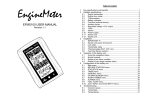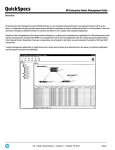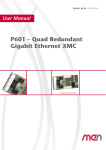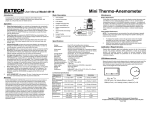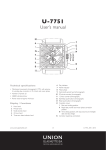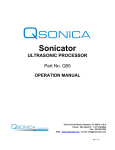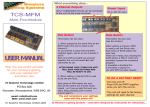Download FUEL FLOW SENSOR INSTALLATION GUIDE
Transcript
Table of content 1 2 FUEL FLOW SENSOR INSTALLATION GUIDE Revision 1 Features ................................................................................................. 1 Installation .............................................................................................. 2 2.1 Overview ....................................................................................... 2 2.2 Fuel compatibility .......................................................................... 2 2.3 Ranging jet .................................................................................... 3 2.4 Flow direction ................................................................................ 4 2.5 Location ......................................................................................... 4 2.6 Fuel filter ....................................................................................... 4 2.7 Reservoir ....................................................................................... 4 2.8 Orientation ..................................................................................... 5 2.9 Mounting ....................................................................................... 6 2.10 Magnet / Magnetic fields ............................................................... 6 2.11 Connecting the sensor to the sender unit ..................................... 7 3 Calibration .............................................................................................. 7 4 Important ................................................................................................ 8 Revision history Revision 1 Changes N/A Date Sept. 2011 Acronyms FF GPM LPM Fuel Flow Gallon (1 US liquid Gallon = 3.785 liters) Per Minute Liter Per Minute 1 Features 2 Installation Using a fuel flow sensor enables EFMS100 system to provide the following information: The fuel flow sensor is a precision instrument which requires careful installation to provide accurate information. • • • • • Fuel flow Fuel used Fuel onboard Time to tank empty Distance to tank empty (after entering your speed) 2.1 Overview To measure the fuel flow, the sensor should be inserted in the fuel line between the fuel tank and the carburetor of the engine. At the heart of the sensor is a precision turbine that rotates freely on robust sapphire bearings. Chemically resistant ceramic magnets that are detected through the chamber wall by a Hall Effect detector (magnetic field detector). Fuel from tank Fuel to engine 1.8 meters (6 feet) cable Wires to sender unit 2.2 Fuel compatibility It is your responsibility to ensure that the fuel you intend to use is compatible with the fuel flow sensor. After several years of continuous test we have found that EFMS fuel flow sensor is very compatible with automotive fuels, many of which contain methanol. 1 2 2.3 Ranging jet 2.4 Flow direction The sensor is delivered with 4 raging jets. Depending on the fuel flow range of your engine, a jet must be inserted in the sensor. The sensor must be inserted in the fuel line so that the large arrow on the sensor matches the direction of the flow. Jet Diameter (hole) 1mm 2mm 3mm 4mm No jet Flow Range: Liter Per Minute Flow Range: US Gallon Per Minute 0.05 – 0.5 0.1 – 1.5 0.15 – 4.5 0.18 – 6.5 0.2 – 10 0.013 – 0.13 0.026 – 0.4 0.039 – 1.2 0.047 – 1.72 0.052 – 2.64 Please ensure that the correct jet size is selected before installation as once inserted, the removal of the jet may damage the sensor. 2.5 Location The best location for the sensor is a low as possible near the fuel tank. Placing the sensor as low as possible will avoid cavitation of the fuel. Cavitation is the formation of vapor bubbles of a flowing liquid in a region where the pressure of the liquid falls below its vapor pressure. Cavitation should be avoided as it will cause inaccurate flow measurements. Since the pressure in the fuel line decreases with the height, it is important to place the flow sensor as low as possible. We recommend placing the sensor below the top of the fuel tank. Placing the sensor near the tank (therefore far from the engine) will minimize the pressure (/flow) pulses caused by the carburetor (/fuel pump). Pressure pulses must be minimized as they will cause inaccurate flow measurements. 2.6 Fuel filter A fuel filter must be inserted between the tank and the sensor to prevent dirt or debris to reach the sensor. These will not block the fuel flow but may lead to the turbine wheel inside the sensor jamming. Insert the jet in the input side of the sensor 2.7 Reservoir Use the flat end of a drill bit of suitable diameter to push the jet all the way to the stop. This requires a bit of force. A small reservoir must be provided between the flow sensor and the carburetor/fuel pump. The reservoir can be a primer bulb or a long fuel line. The reservoir will minimize the pressure (/flow) ripple (/pulse) caused by the carburetor (/fuel pump) and will provide optimal performance of the sensor. 3 4 2.8.3 2.8 Orientation 2.8.1 Summary Vertical axe ENGINE (CARBURETOR/PUMP) For optimal performance (in particular at low flow rates) the axe of the turbine must be almost vertical. FILTER TURBINE AXE “RESERVOIR” TANK SENSOR 2.8.2 Bubbles Please ensure that no bubbles can be trapped inside the sensor. Bubbles will cause inaccurate flow measurements. The best way to avoid bubbles inside the sensor is to allow bubbles to escape. 2.9 Mounting This is done by pointing the outlet slightly upwards and the inlet slightly downwards. The flow sensor is a precision instrument which must be isolated from vibrations. VERTICAL AXE OUT IN 2.10 Magnet / Magnetic fields The sensor contains 3 magnets which are part of the turbine wheel assembly. The magnetic field generated by these magnets is used to measure the flow rate. It is important to mount the sensor far from strong magnetic fields. For the same reason, the fuel line on the OUT side (towards the engine) should go up immediately after the exit of flow sensor. 5 6 2.11 Connecting the sensor to the sender unit The 3 wires at end of the cable must be connected to EFMS sender unit. Wire Shield Red Blue Function Ground Power provided by the sender unit to the fuel flow sensor Signal from fuel flow sensor to sender unit Terminal on sender unit GROUND +VPWR OUT FLOW IN 4 Important Note to Pilots Always have a visual indication of the fuel level available, either by means of a sight glass, direct tank observation or a known, reliable secondary fuel level gauge. Fuel level indication by means of calculated fuel burn is subject to errors both by entering incorrect starting fuel levels as well as mechanical problems causing the flow sensor impeller to turn too slowly, resulting in under reading fuel burn and thus over reading remaining fuel. As pilot in command of an aircraft it is your responsibility to ensure that you have sufficient fuel to reach your intended destination. Always ensure that you have a generous amount of reserve fuel and never use your reserve fuel except in an emergency if it is unavoidable. 3 Calibration Refer to EFMS100 user manual for the description of the calibration procedure. The calibration procedure should provide a PULSE/VOLUME RATIO within +/-5% compared to the values provided in the table below. If the value you calculate with the calibration procedure is far from the value provided by the table below, it means that the flow sensor is not installed properly. NOMINAL (i.e. APPROXIMATIVE) values of “PULSE/VOLUME RATIO” Do not use these values but instead, use the calibration procedure to calculate the correct value. Jet Diameter (hole) 1mm 2mm 3mm 4mm No jet Pulses per Liter Pulses per US Gallon (=Pulse per Liter x 3.785) 17000 7000 3500 2100 1420 64345 26495 13247 7948 5375 7 8





